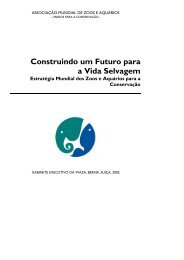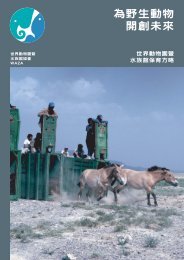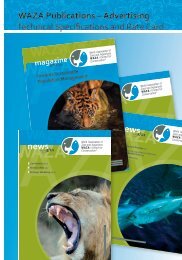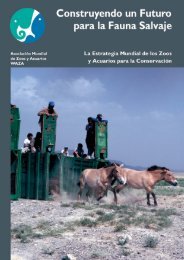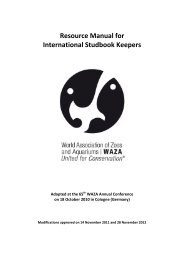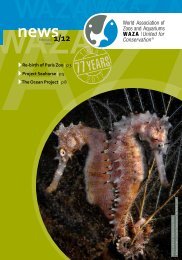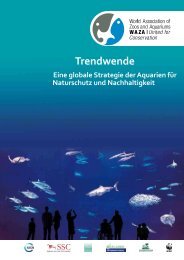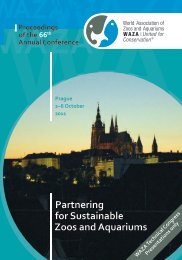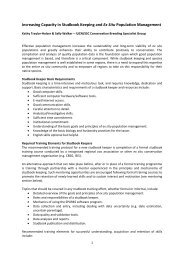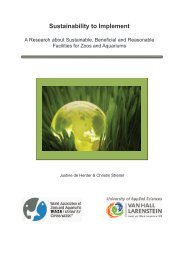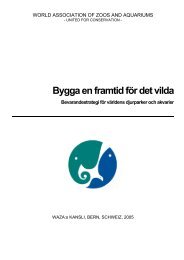Towards Sustainable Population Management - Waza
Towards Sustainable Population Management - Waza
Towards Sustainable Population Management - Waza
Create successful ePaper yourself
Turn your PDF publications into a flip-book with our unique Google optimized e-Paper software.
WAZA magazine Vol 12/2011<br />
Terrestrial Vertebrates<br />
in ISIS Zoos<br />
Conde et al. (2011a) found that<br />
one-quarter of the world’s described<br />
bird species and almost 20% of its<br />
mammal species are represented in<br />
ISIS zoos. In contrast, the representation<br />
of reptiles and amphibians is<br />
considerably lower with just 12% and<br />
4%, respectively (Fig. 1). The picture<br />
is slightly different when we focus<br />
solely on threatened species. Mammals<br />
have the highest representation,<br />
with 24%, 23% and 19% of species<br />
classified as Vulnerable, Endangered<br />
and Critically Endangered, respectively<br />
(Fig. 2). Although the bird collections<br />
account for one-quarter of all<br />
known species, the representation of<br />
threatened species is lower (Vulnerable<br />
= 17%, Endangered = 17%, Critically<br />
Endangered = 9%). However, the<br />
lowest representation of threatened<br />
species is for amphibians, with only<br />
4%, 2% and 3% of species classified as<br />
Vulnerable, Endangered and Critically<br />
Endangered, respectively (41%<br />
of amphibian species are threatened<br />
and ISIS zoos hold only 4% of all<br />
described amphibian species). IUCN<br />
has so far only assessed the conservation<br />
status of 1,672 of the 9,205<br />
described reptile species. From this<br />
incomplete survey, zoos hold 37%,<br />
28% and 51% of species classified as<br />
Vulnerable, Endangered and Critically<br />
Endangered, respectively. As a whole,<br />
roughly one in seven threatened species<br />
of terrestrial vertebrates (15%)<br />
are represented in ISIS zoos.<br />
Although individual zoos usually<br />
do not hold large numbers of individuals<br />
of particular species of conservation<br />
concern, zoos as a global network<br />
hold important populations for<br />
some of the more highly threatened<br />
species. For example, almost onequarter<br />
of the amphibian populations<br />
and 21% of the mammal populations<br />
include more than 250 individuals<br />
worldwide (Fig. 2). The figure is<br />
smaller for bird and reptile populations;<br />
only 8% and 6%, respectively,<br />
exceed 250 individuals.<br />
Fig. 1<br />
The number of terrestrial vertebrates in ISIS zoos compared<br />
to the number of described species.<br />
Threatened Species<br />
The distribution of threatened species<br />
among the world’s ISIS zoos does<br />
not coincide with the distribution of<br />
threatened species in the wild (Fig. 3).<br />
Zoos that hold most threatened species<br />
are concentrated in Europe and<br />
North America, while most of the<br />
wild populations of threatened species<br />
are concentrated in the tropics.<br />
However, it is important to emphasise<br />
that this map only shows species<br />
richness and does not account for the<br />
number of individuals per species.<br />
Consequently, zoos that hold a large<br />
number of species, albeit populations<br />
consisting of few individuals, would<br />
rank higher (brighter on this map)<br />
than zoos having small numbers of<br />
species with large population sizes.<br />
In this sense, Fig. 3 only shows the<br />
distribution of threatened species<br />
across zoos and it should not be seen<br />
as a measure of how zoos contribute<br />
to conservation.<br />
27<br />
»



